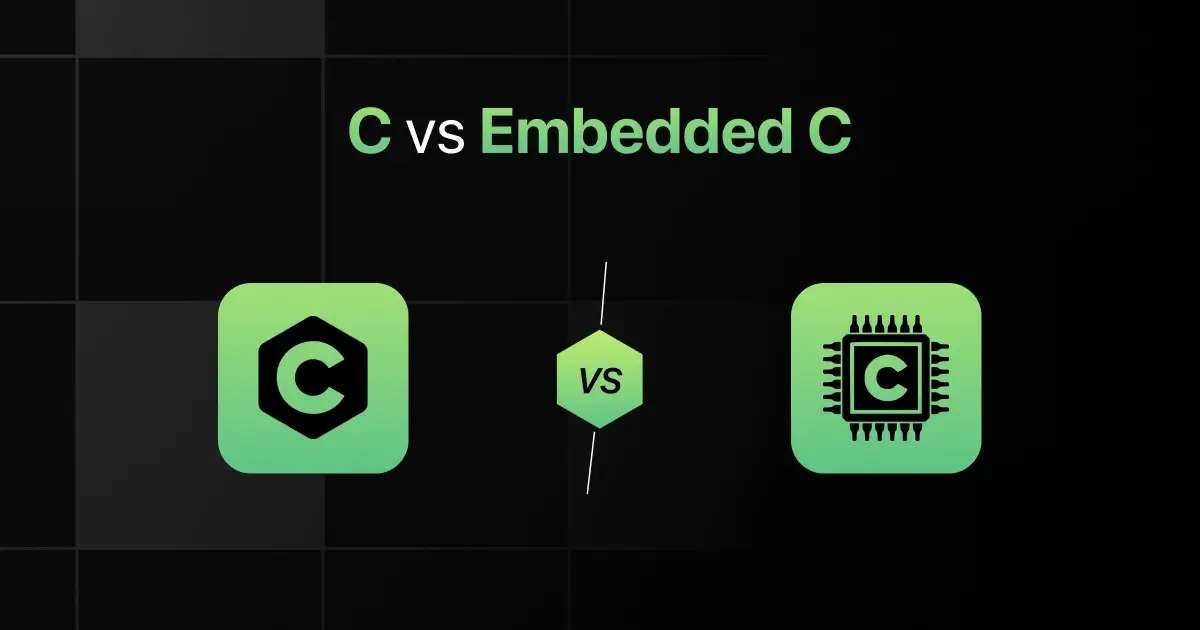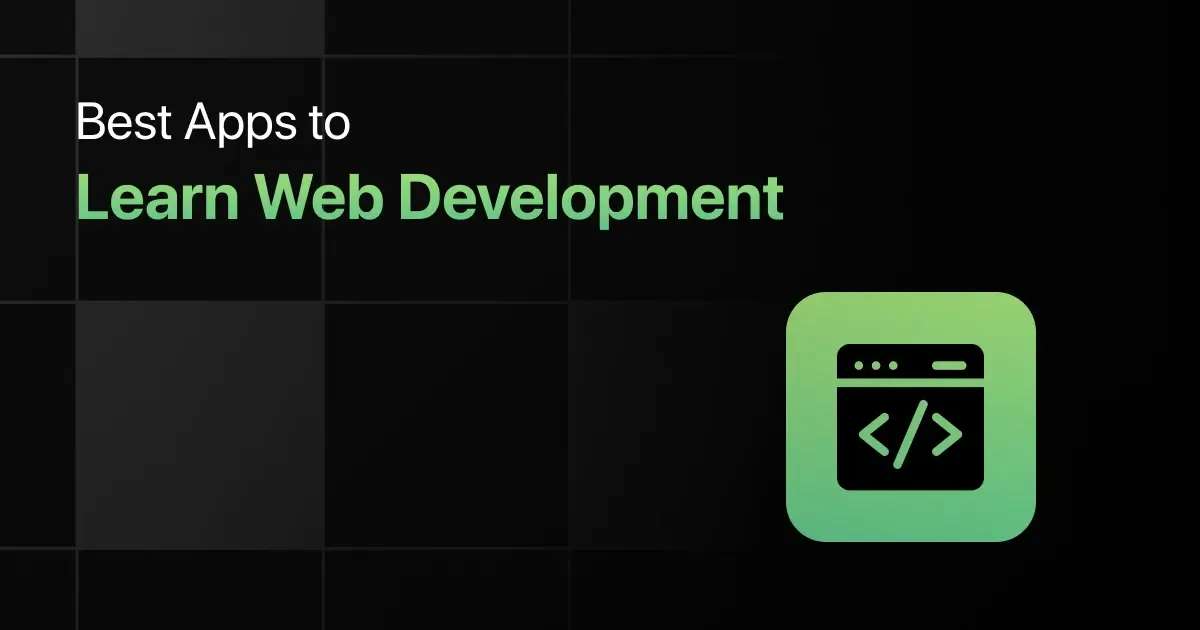C vs Embedded C: Key Differences

When comparing C and Embedded C, looking at what sets them apart is important. The discussion about C vs Embedded C is common among programmers deciding which language to use for their projects.
The question of C vs Embedded C which is better? or C vs Embedded C which is best? depends on what you need for your specific project.
In this article, let’s know the differences between C and Embedded C.
C vs Embedded C: Understanding the Key Differences
When comparing C and Embedded C, it’s crucial to understand the key distinctions that define their usage and capabilities.
One of the most important differences is that C is a general-purpose programming language used for system and application software, while Embedded C is an extension of C used for programming microcontrollers and embedded systems.
The following are other major differences between C and Embedded C:
| S. No. | Parameters | C | Embedded C |
|---|---|---|---|
| 1 | Developed By | Dennis Ritchie at Bell Labs | Extension of C by various vendors |
| 2 | Release Year | 1972 | Evolved from C in the late 1980s |
| 3 | Paradigm | Procedural, structured | Procedural, structured |
| 4 | Syntax | Similar to C++, more general-purpose | Similar to C with added functionality for embedded systems |
| 5 | Performance | High performance, depends on hardware | Optimized for microcontroller and embedded hardware |
| 6 | Applications and Use Cases | System software, applications, operating systems | Firmware, microcontroller programming, embedded systems |
| 7 | Learning Curve | Moderate | Steeper, due to hardware-specific considerations |
| 8 | Libraries and Frameworks | Standard libraries like stdio.h, stdlib.h | Specialized libraries for microcontrollers and embedded devices |
| 9 | Platform Independence | Limited, platform-specific dependencies | Typically non-portable, specific to hardware platforms |
| 10 | Concurrency and Multithreading | Supported through libraries like pthreads | Limited, focus on real-time processing |
| 11 | Tooling and IDE Support | Wide support (GCC, Visual Studio, etc.) | Specialized tools (Keil, MPLAB, etc.) |
| 12 | Memory Management | Manual memory management | Manual memory management with hardware constraints |
| 13 | Error Handling | Basic error handling | Hardware-specific error handling |
| 14 | Security | Basic security features | Security features depend on hardware capabilities |
| 15 | Scalability | Scalable for a wide range of applications | Limited to specific hardware capabilities |
| 16 | Key Features | Pointers, dynamic memory allocation, system-level access | Direct hardware manipulation, interrupts, low-level access |
| 17 | Integration with Other Technologies | Integrates with various system and application software | Integrates with hardware components and firmware |
| 18 | Community and Support | Large global community | Smaller, specialized community |
| 19 | Job Opportunities | Broad opportunities in software development, system programming | Specific opportunities in embedded systems and firmware development |
| 20 | Future Prospects | Stable and continuously evolving | Growing with the rise of IoT and smart devices |
C vs Embedded C: Which One to Choose?
Choosing between C and Embedded C can be challenging, but by understanding their distinct advantages, you can make an informed decision.
Choose C If:
- You aim to work as a software developer focusing on creating foundational software like operating systems, compilers, or high-performance computing systems.
- You appreciate a language that allows you close control over system resources and direct manipulation of hardware through pointers and manual memory management, essential in system-level programming.
- You value a language known for its portability and efficiency, enabling the development of software that can run across various hardware platforms with minimal overhead.
- You seek a language that, despite its steep learning curve, provides a strong foundation in computer science fundamentals, influencing many other high-level programming languages.
- You focus on developing system software, device drivers, or applications where performance and resource utilization are critically important, and where you need granular control over hardware.
Choose Embedded C If:
- You are specifically interested in developing firmware and low-level software for embedded devices like microcontrollers, consumer electronics, and automotive systems.
- You value a language that is extensively used in the embedded systems industry, providing the tools and capabilities to directly manipulate hardware, manage memory, and integrate with specific hardware functions.
- You need a language that excels in environments with limited computational resources and power, where every byte of memory and each processor cycle counts.
- You seek to work in a field that requires a deep understanding of both hardware and software interactions, often in real-time operating systems (RTOS) and critical safety systems.
- You focus on projects that involve direct control of hardware, custom-tailored solutions for specific devices, and the optimization of software to run with constraints on memory and processing power.
Final Words
The main difference between C and Embedded C lies in their design and use.
The purpose of understanding the C vs Embedded C difference is to choose the right tool for the job, depending on factors like the project’s size and how easy it is to maintain.
Frequently Asked Questions
1. What are the key differences between C and Embedded C?
The key differences between C and Embedded C are:
- C is a general-purpose language, while Embedded C is optimized for developing firmware for embedded systems.
- C can run on virtually any type of computing device, whereas Embedded C is often restricted to microcontrollers and embedded systems.
- Embedded C includes direct hardware manipulation capabilities, which standard C does not emphasize.
- C offers broader library support compared to Embedded C, which is more hardware-specific.
2. Which is better C or Embedded C? Which one to choose?
Both are better in their ways. Choose C for general software development and Embedded C for embedded systems development.
3. Which is faster, C or Embedded C?
Both can be equally fast; performance depends more on the hardware and application specifics than the language variant.
4. What are the primary use cases of C and Embedded C?
The primary use cases of C and Embedded C are:
- C is used for system/software development.
- Embedded C is used for programming embedded systems.
5. Which one is easy to learn for Beginners, C or Embedded C?
C is easier for beginners as it does not require specialized knowledge of hardware.
6. Can C and Embedded C run on different platforms?
Yes, both can run on various platforms, but Embedded C is typically used on specific hardware platforms.
7. Can I develop mobile apps using C and Embedded C?
No, C and Embedded C are not used for mobile app development.
8. What are the job prospects for C developers versus Embedded C developers?
Both have strong job prospects, but C developers often have broader opportunities, while Embedded C developers are more niche, focusing on embedded systems.
Explore More C Programming Resources
- C Programming Learning Websites
- C Programming Practice Websites
- C Programming YouTube Channels
- C Programming Project Ideas
- C Programming Apps
- C Programming IDEs
- C Programming MCQ
Explore More Comparisons
Related Posts


Best Apps to Learn Web Development
Ever thought about building your own website or launching a career in tech but don’t know where to start? With the …










